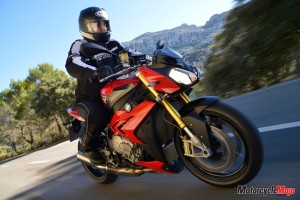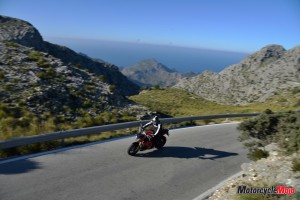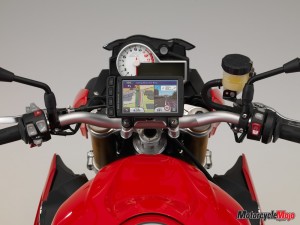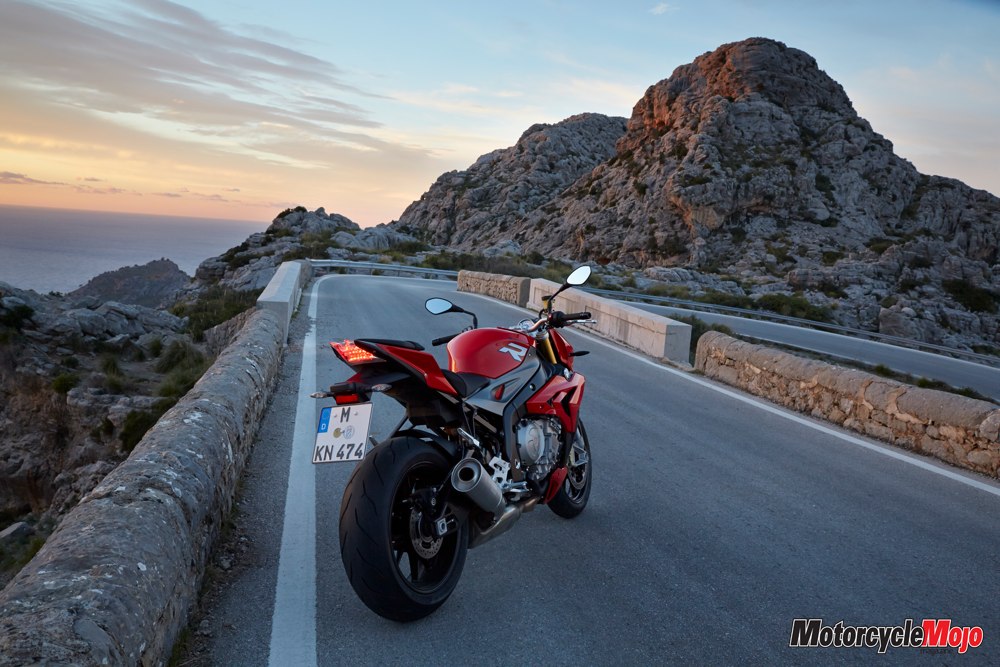This hooligan might give its Euro brethren a run for their money
When BMW launched the S1000RR in late 2009, it took the supersport class to a new level. The bike out-powered its nearest competitor by about 10 horsepower, it handled like a race bike, and it was available with an electronics package that included race ABS and adjustable traction control. And even though it didn’t immediately enjoy racetrack success, in its first year of production it won several magazine shootouts against its Japanese rivals. It’s not surprising, then, that with such a sharp focus on performance, BMW engineers at the time weren’t yet thinking of building a naked bike based on the S1000RR platform. However, now that the S1000RR has proven itself in showrooms, BMW’s focus has finally turned to spinning off a bike from the S1000RR, one that would offer the RR’s performance and handling, but in an ergonomically friendly package for everyday use.
 Therefore, a couple of years ago, the guys at BMW took an S1000RR off the assembly line, stripped off the bodywork, bolted on a handlebar and let test riders loose on a naked RR test mule. Test riders loved the outright wickedness of the machine, although apparently, it proved too nervous for production. Stripping the RR of its fairing messed up the bike’s aerodynamics and weight balance, and because it was highly wheelie-prone, it was too much of a handful to go into production. They went back to the drawing board and the result is the 2014 S1000R, launched recently in Mallorca, Spain.
Therefore, a couple of years ago, the guys at BMW took an S1000RR off the assembly line, stripped off the bodywork, bolted on a handlebar and let test riders loose on a naked RR test mule. Test riders loved the outright wickedness of the machine, although apparently, it proved too nervous for production. Stripping the RR of its fairing messed up the bike’s aerodynamics and weight balance, and because it was highly wheelie-prone, it was too much of a handful to go into production. They went back to the drawing board and the result is the 2014 S1000R, launched recently in Mallorca, Spain.
In losing one “R,” many other changes were incorporated into BMW’s new, high-performance roadster to make it a more agreeable ride. To cope with the altered weight bias after removing the fairing, engineers stretched the wheelbase by 22 mm to 1429 mm, which they achieved by adding a couple of links to the drive chain and pulling the wheel back in the swingarm axle slots. They also kicked out the steering rake by 0.8 degrees to 24.6 and increased trail by 5 mm to 98.5 mm. These changes were meant to reduce instability at speed, a problem that would have been exacerbated by the wide handlebar and lack of wind protection.
 The S1000R’s 999 cc inline-four has been subdued somewhat for naked bike duty, with revised cam profiles and different engine mapping. It produces 160 hp, a drop of 33 hp compared to the RR; however, it produces the same peak torque, at 83 ft-lb, and it peaks 500 rpm sooner than the RR, at 9250 rpm (and the engine also redlines 2000 revs sooner, at 12,000 rpm). More importantly, though, the R makes 7.5 ft-lb more torque below 7500 rpm. Internally, gear ratios are identical to the RR, but the final drive ratio has been shortened a bit to 2.65, compared to 2.59 for the RR.
The S1000R’s 999 cc inline-four has been subdued somewhat for naked bike duty, with revised cam profiles and different engine mapping. It produces 160 hp, a drop of 33 hp compared to the RR; however, it produces the same peak torque, at 83 ft-lb, and it peaks 500 rpm sooner than the RR, at 9250 rpm (and the engine also redlines 2000 revs sooner, at 12,000 rpm). More importantly, though, the R makes 7.5 ft-lb more torque below 7500 rpm. Internally, gear ratios are identical to the RR, but the final drive ratio has been shortened a bit to 2.65, compared to 2.59 for the RR.
The S1000R comes standard with all of the RR’s race-ready goodies, including a slipper clutch, ride-by-wire throttle control, selectable ride modes, semi-linked Race ABS, ASC (automatic stability control), adjustable front and rear suspension and a steering damper. It also gets the racier options, like adjustable DTC (dynamic traction control) and electronically adjustable, semi-active DDC (dynamic damping control) suspension. The DTC is part of the $950 Sport package, which includes an electric shift assist to permit clutchless, open-throttle upshifts. Opting for this package adds Dynamic and Dynamic Pro ride modes to the standard Rain and Road modes, via a coding plug added to the wiring harness under the seat.
BMW designers have done a fine job of stripping the supersport, and the S1000R actually looks better in the metal than it does in photos. It’s angular and futuristic, but not as bold as the new Kawasaki Z1000, which has taken naked bike styling to a very different place. Where the BMW’s styling comes apart for me is below the waistline, where its exposed crankcases and muffler still look like they were meant to be concealed by a fairing. BMW does have an accessory engine spoiler to cover this, available either alone or as part of the $775 Dynamic package, including the electronically adjustable, semi-adaptive DDC suspension.
 The S1000R has an upright riding position with ample legroom. Foot pegs have been moved forward, the handlebar moved rearward and upward, and seat height is 814 mm, a tad lower than the 820 mm of the RR. Tire sizes remain 120/70ZR17 and 190/55ZR17, and wet weight is 207 kg, just half a kilogram more than the RR.
The S1000R has an upright riding position with ample legroom. Foot pegs have been moved forward, the handlebar moved rearward and upward, and seat height is 814 mm, a tad lower than the 820 mm of the RR. Tire sizes remain 120/70ZR17 and 190/55ZR17, and wet weight is 207 kg, just half a kilogram more than the RR.
European weather has been exceptionally unseasonable this year, and during our morning ride briefing, we were told it could get as low as 3 degrees Celsius in the mountains of Mallorca. Some journalists on an earlier wave even had to cut their ride short due to snow. Fortunately, the white stuff wasn’t in our forecast, and my test bike was equipped with the optional heated grips.
Upon start-up, I first noticed that the S1000R produces the same, nearly intoxicating exhaust growl as its RR brother. It’s by no means loud, but rather a rich, low-pitched growl – I kept rolling off the throttle in town just to listen as its burbling, popping overrun reverberated from the surrounding buildings.
The roads got progressively tighter as we headed out of town and into the mountains, and within an hour they were almost too tight for even a supermoto. Switchbacks curled around themselves, sometimes at more than 180 degrees, and the S1000R proved just a bit ponderous in these tight turns. The more relaxed steering geometry gave the front end a slightly disconnected feeling, though to be fair, Mallorca’s pavement did little to inspire confidence. We were told during the briefing that the light-coloured asphalt found throughout the Balearic island was somewhat lacking in grip. What we discovered was pavement with the friction coefficient of eggshell.
The cold morning temperatures, combined with that eggshell pavement, allowed the front tire to give just enough in the tighter turns to cause a nervous twitch at the handlebar. Sometimes both tires lost grip – first the front, then the rear – which meant speeds remained cautiously low. Later in the day, when temperatures were a bit higher, we braved a more enthusiastic pace, though I continued braking on the side of caution when going into turns and tried to keep lean angles closer to upright than horizontal.
Our test bikes were equipped with DDC and DTC, and these ride modes made a considerable difference in the bike’s behaviour. The ride modes integrate throttle control, ABS, DSC and DTC settings; I remained mostly in Road mode, which provided maximum power, but with full ABS operation and maximum wheel-lift control. The DDC suspension was initially set to Normal, though the lack of traction prompted me to select the Soft setting, which improved handling – and confidence – in these unusually slippery conditions. My only gripe with the bike is that its shorter gearing causes it to rev a bit high at highway speeds, about 5000 rpm at 115 km/h, which blurs the mirrors considerably. Fortunately, the buzzing didn’t intrude on rider comfort.
Among others, one area where BMW seems to excel is in engine management, and the S1000R is an example. It’s a docile machine if needed, like when strolling about in congested areas, yet if you wick it up a few notches (especially in one of the Dynamic modes), it becomes a genuinely heart-palpitating hooligan machine. I kept the hooliganism to a minimum, but I did see other journos readily popping third-gear wheelies. The bike certainly is capable of such antics, and the electronics are even tuned to allow for such behaviour. Of course, you can also turn off the ABS and DTC.
Temperatures rose into the double digits later in the day, as we headed back south toward our hotel along more open roads with darker, grippier pavement. Along these roads, I switched the ride mode to Dynamic, the suspension to Hard, and I turned the throttle closer to its stop. Here the S1000R was in its element, and it bolted along at speeds upwards of 160 km/h without issue. The changes BMW has made to the S1000R’s chassis geometry have eliminated the rider-induced weaving tendency of many naked bikes with wide handlebars, and it handled the fast, sweeping turns with confidence-inspiring stability.
BMW has priced the S1000R aggressively at $14,700. At that price, it undercuts the S1000RR by almost $3,000. It’s also considerably less expensive than other naked bikes in BMW’s line-up, coming in at $2,500 less than the K1300R and $1,350 less than the R1200R boxer. Pricing is on par with the Aprilia Tuono V4 R and the Triumph Speed Triple ABS, so it might give its naked European competitors some grief in the showroom.
Although BMW hadn’t originally planned to spin off a naked bike from the S1000RR, the bike is exactly what its designers had planned. It’s a comfortable and relatively docile machine when puttering about town, with less of a supersport focus than its RR brother, while still maintaining a fair amount of the RR’s performance and handling.



































